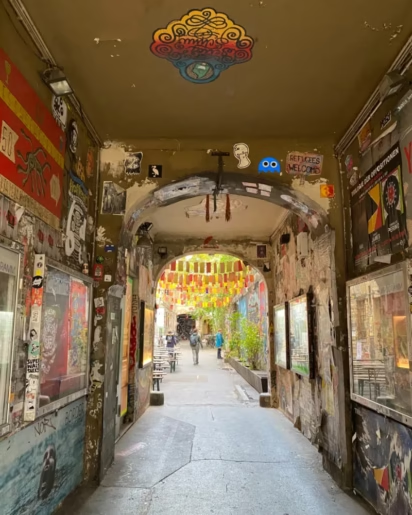Visit Anne Frank Zentrum in Berlin to learn more about the life of the famous diarist in a small museum / documentation center.

The Anne Frank Zentrum in Berlin is a small documentation center and museum dedicated to the life of Anne Frank, as well as an education center to increase understanding and tolerance. The main reason for most to visit is to see the All About Anne (Alles Über Anne) exhibition — a chronology of the life and diary of Anne Frank. Buy time-slot reservation tickets online to skip-the-queues and waiting time.
Anne Frank Zentrum in Berlin
The Anne Frank Zentrum in Berlin primarily chronicles the life of Anne Frank (1929-1945) but also aims to educate visitors on the links to history as well as how to take social responsibility, and how to engage with freedom, equal rights, and democracy.
The main part of the center is the All About Anne (Alles Über Anne) exhibition on the life of Anne Frank and her famous diary.
A further section is more interactive and although aimed at children, adults may also find much to enjoy here. This part for example explains diaries and their role in understanding history. It also explains the continuing cases of antisemitism and racism that still occur daily in all parts of the world.
Visitors are encouraged to design memorials and think about why it is important to remember and commemorate the lives of people. School groups participate in theater, which could make the whole center a bit noisy at times.
All About Anne Exhibition in Berlin
The All About Anne exhibition is the main part of the Anne Frank Zentrum in Berlin. The Berlin Zentrum cooperates with the Anne Frank House in Amsterdam but as so few items related to Anne Frank survived, only copies of memorials are on display in Berlin.
The exhibition uses photos, information boards, maps, videos, and interviews with family and people who knew the Frank family, to cover major phases in the life of Anne and the Frank family. All information is in both English and German. Visitors are allowed to change some of the cards to alter the wall displays with information that they find particularly pertinent while viewing the displays.
The main themes covered include the life in Frankfurt am Main where Anne was born, the move to Amsterdam in 1933 (other family moved to Switzerland and the USA), her early school years, increasing restrictions on Jews following the occupation of the Netherlands by the Nazis, the years in hiding (1942-44), the difficult six months in concentration camps including Auschwitz and Bergen-Belsen, where Anne and her sister Margot died in 1945.
The final section is on the decision of her father Otto Frank (1889-1980) to publish her diary in 1947 — Anne revised parts of the diary as she was hoping to publish her memories after the war. Anne’s diary and writings were found by helpers the day after the house was raided and later returned to Otto — the only member of the Frank family in Amsterdam to have survived the war.
The short videos and interviews are particularly interesting. Visitors listen on the free audio guide but it is a good idea to visit early morning, or it may be necessary to wait for previous visitors to complete the videos in order to watch it from the start.
A thorough study of the documents on display and videos in the exhibition should take just less than an hour. Much more time could be spent in the interactive sections at the end, especially when traveling with children.
A special activity sheet is available at the museum for children and young adults, or download for free from the website.
Anne Frank Center Berlin Visitor’s Information

Opening Hours and Tickets
The Anne Frank Zentrum Berlin is open Tuesday to Sunday from 10:00 to 18:00. Due to the huge popularity of the museum with school groups, it is sensible to visit the first or last hour of opening, and weekends in the morning rather than the afternoon.
Tickets are €6 for adults and €3.50 for ages 11 to 18 and students. Family ticket options and groups discounts are available. The Museum Pass Berlin and most other Berlin passes are accepted.
Buy tickets online with time-slot reservations — first visitor in the morning ensures no waiting for others to complete videos, recordings, etc.
Tripadvisor users mostly enjoy the exhibition, although some feel the price is a bit high for a documentation center, especially for visitors who had been to the Anne Frank House in Amsterdam.
To add value, visit the free Otto Weidt Museum Blindenwerkstatt (Museum for Blind Workers) in the same courtyard. Here Otto Weidt employed many blind Jewish workers and saved the lives of many, even rescuing some workers from camps by bribing the Gestapo. The lives of Otto Weidt, his wife Else, and the workers are probably more remarkable than the displays but it is still worth a few minutes when in the vicinity.
Getting to the Anne Frank Zentrum in Berlin
The Anne Frank Zentrum is located at Rosenthaler Straße 39, across the square from the Hackescher Markt S-Bahn station. Tram M1 and M5 also stop here. The entrance is via a passageway immediately to the right of the rather garish modern shop facade of Die Hackeschen Höfe.
Often the museum sign and much of the passage are covered by graffiti and street art. The Zentrum is on an upper floor at the rear of the courtyard, which fits well with the original name of Anne Frank’s diary. It was first published as Het Achterhuis, in English as The Secret Annex, but more directly translatable as the house in the back. Currently, Anne Frank — The Diary of a Young Girl seems more common in English at Amazon.
Anne Frank of course never lived (or even visited Berlin). She was born in Frankfurt and briefly lived in Aachen before the Frank family settled in the Netherlands. The Anne Frank House in Amsterdam where the Frank family went into hiding is one of the most popular museums in the Netherlands — tickets are only sold online and with strict time-slot reservations.

